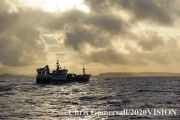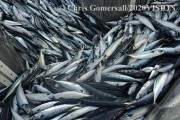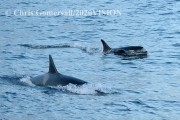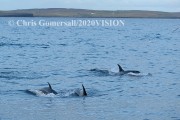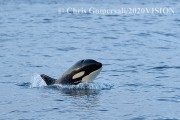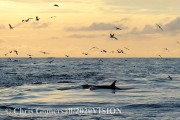Killer Whales and the Mackerel fishing industry in Shetland
Posted by Chris Gomersall on Wednesday 24th October 2012 | Sea Mammals in Shetland
Although Killer Whales cashing in on purse-net fishing by local boats has been known in Shetland waters for some time, in recent years this spectacle has received considerable media coverage, even making it onto national television. To summarise this spectacle, these whales essentially follow the mackerel migration, feasting on them as they go. As the vessels begin to haul their nets the whales tune into the change in revs from the vessels engines and home in to hoover up excess spillage of mackerel from the boats vast nets. SN team member Chris Gomersall shares his account from a recent photographic assignment aboard one of these vessels.
For the third year in a row, I find myself spending much of October in Shetland. And it’s not the rare birds that bring me here, exciting as that might be. What started as a photography assignment for the 2020VISION project has become a bit of a personal obsession, and I still have some unfinished business, in the shape of a massive, black and white torpedo with an over-sized dorsal fin. The killer whale. The trouble is, they don’t always arrive on cue. Or even appear at all.
The logistics of this operation are quite complicated, and entirely beyond my control. To summarise, it involves going out to sea as a guest on a pelagic mackerel trawler. Sometimes (as last year), we end up in Norway, waiting several days for some vital spare part to arrive from Sweden. Usually it’s the fish markets and the global price of mackerel that dictate when the season will commence; weather is very much a secondary consideration. Anyway, after ten days of hanging around, trying not to get impatient and filling my time quite pleasurably visiting old friends in the islands and stalking otters on the shore, my friendly skipper decides the time has come. At this point, I have no idea whether we will be gone for a couple of days or a couple of weeks, but I’ve cleared my diary as best I can and hope for as much sea time as possible. It’s a late night departure, via the fuel berth in Lerwick. Now, for anybody who might be feeling pangs of sympathy for me having to endure a long voyage on a trawler in the North Sea in the autumn, I ought to just point out that I have sailed on far worse cruise ships – these modern 70 metre vessels are not only highly technological they are also very comfortable for the crew, but of course they are still working boats – just very different from the deep sea Grimsby trawlers I remember from my youth. So there’s no need to pity me.
As it turns out, we don’t have to steam very far before we encounter the fish shoals, just outside St Magnus Bay, and as luck would have it it’s a beautifully calm day – which means I can observe from the foredeck. There are fabulous views of Papa Stour, Foula and the Eshaness cliffs in the early morning light, and the slight swell makes for good cetacean-watching conditions. In the distance, somewhere over near Hillswick, I see some wispy splashes that turn out to be dolphins breaching. Only two or three, quite fast-moving, but no discernible features at this range – possibly white-beaked dolphin? Then, just off our bows, a larger whale surfaces briefly: unmistakably a minke. Unfortunately it doesn’t reappear, and another photo opp vanishes with it.
Meanwhile, the fishing is going well, and our first haul of the net brings in a large bag of mackerel, but attracts no orcas. Hours pass, and as the sun lowers I see a tall whale spout against the light in the west. Just the once, and I have little idea what it might be, but presumably a large rorqual of some description. Frustrating, this whale-watching! Our second haul is more productive, from my point of view, and as the nets are being cleaned after all the fish have been pumped aboard, I spot the distinctive dorsal fin of a bull orca, closing in fast. It’s soon clear that he’s not alone, and we have a small pod of about a dozen orca around the boat. By now it’s about 5pm, and the whales stay with us for 20 minutes or so, occasionally spy-hopping for the briefest of moments, and not quite posing long enough for me to train my lens on them. As we trail the net and pick up speed, stray fish fall away and this prompts a bit more activity from the orcas, including some breaching. I photograph what I can, using two camera bodies – one fitted with a 200-400mm zoom lens, the other with a 70-200mm.
Naturally there are more misses than hits. They don’t break surface for long, and usually by the time you’ve found the animal in the viewfinder, pressed the shutter, and the camera mirror has moved out of the way, your subject is back underwater again! So there’s a lot of guesswork, and sighting along the top of the lens trying to anticipate the next leap. And all too soon, the whales peel off and go to look for the next boat that’s got fish. Our crew make another good catch, and unbelievably the fish holds are full within the first 24 hours, so it’s back to Lerwick for us.
It actually takes longer to pipe the fish in to the processing factory than it does to catch them in the first place. There’s nothing left for me to do except book my return trip on the Northlink ferry, and maybe start dreaming about October 2013. Of course I will be back in Shetland before then, joining Brydon Thomason in leading two wildlife photographic workshops in June 2013 – when there’s always the chance of orcas close inshore!


